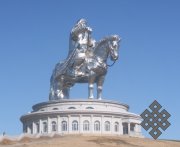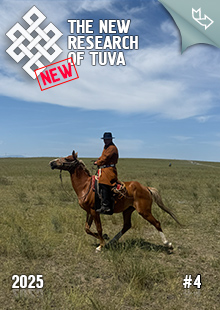 Over the past several decades, the Asian part of the world has been taken over by a veritable Genghis-Khan-mania. Especially residents of Central Asia are given to worshipping and honoring of the great military leader, who conquered half of the Earth’s globe. These areas felt an acute deficiency of real, not mythical historical heroes, after the Soviet idols had been dethroned. Some days ago, I noticed a curious announcement saying that thousands of well-to-do Kazakhs expressed a wish to undergo quite expensive DNA analysis, in order to find out whether, by chance, they might not be descendants of the founder of the Golden Horde.
Over the past several decades, the Asian part of the world has been taken over by a veritable Genghis-Khan-mania. Especially residents of Central Asia are given to worshipping and honoring of the great military leader, who conquered half of the Earth’s globe. These areas felt an acute deficiency of real, not mythical historical heroes, after the Soviet idols had been dethroned. Some days ago, I noticed a curious announcement saying that thousands of well-to-do Kazakhs expressed a wish to undergo quite expensive DNA analysis, in order to find out whether, by chance, they might not be descendants of the founder of the Golden Horde.
In Ulan-Bator, which I had the luck to visit recently, I did not notice any special fanaticism relating to the khan of all khans on the part of the Mongols. Yes, right by the entrance to the government building you can see a bronze Genghis Khan sitting on a throne. But slightly further off, there is a monument to the leader of the world’s proletariat. The unknown sculptor immortalized Ilyich in his favorite pose – full length, staring into the bright future. And close by, we found a monument to the most faithful friend of the USSR, the last leader of Mongolian communists, comrade Tsedenbal, who died in Moscow, forgotten by all. From the stories of Sharyn Tsolmon, leader of the secretariat for propagation of initiative for transparency of mining industries, who was escorting us around the capital, we found out that after the collapse of the Union, his country also experienced a perestroika and revolutions. However, all these historical stages, including a changeover from one ideology to another, the Mongols survived bloodlessly.
Of course, there were some adventurers that were calling on the nation to throw down the bronze leaders, who did not even manage to build communist in a country where the population never topped one million. However, fortunately they did not listen. Wise Mongols, who were brought up on the values and philosophy of Buddhism, decided that it is senseless to rewrite history, no matter how unacceptable it may seem to the contemporary generation. It has to be taken as it was, and as it is. Life will give to each of us a chance to bring light or dark colors into it.
Most of all, Genghis Khan was omnipresent on Mongolian vodka. The stern image of the great leader either alone or surrounded by his companions decorated bottles of various forms and colors. As we understood during our short visit to Ulan-Bator, alcohol industry of Mongolia mercilessly exploits this hallmark. If it is vodka, it is definitely called “Genghis Khan”. However, their brand of the world’s most popular drink is a degree weaker that “Russkaya”.
As the members of the Kyrgyz delegation, who have tasted “Genghis Khan”, reported, it has a very good taste, almost no odor, and the most important thing – no headache next morning.
Already in Bishkek knowledgeable friends advised us, that if we are planning to bring something like presents from Mongolia, it should be vodka first.
This country and people are amazingly similar to our own homeland. Already during the ride from the airport to the hotel, my countrymen could not tear themselves from the landscape behind the window, and kept exclaiming: “Oh, this road is exactly like the road to Naryn!” Pastures all around, surrounded by mountains. True, Mongolian mountains are not as high and as snowy, they look more like hills. But the roads are exactly the same – uneven, with bulges and potholes.
Ulan-Bator astonishes in its contrasts. The outlying districts still contain many yurts, where thousands of families live; next to them, single family houses of fired bricks are being built. The yurts are lower than ours, with flatter roofs. On top of the thick felt layer, there is always another layer of waterproof canvas. This is where the herdsmen take shelter in fifty degrees of cold. The internal furnishings are more modest – it shows right away that this is a dwelling of a nomadic herdsman who is here today, and tomorrow – hundreds of kilometers away, in the steppe.
The city center is being quickly built up. Office buildings and hotels of glass and cement are growing, such as you never see in Bishkek. Sidewalks, squares, roads – building and renovation is going on everywhere, the entire capital is like a construction site.
All this speaks eloquently about the economic rise of the country. Really, we have a lot to learn from the Mongols Twenty years ago this was an undeveloped rural agricultural country. Ulan-Bator and other towns were built by Red Army soldiers. That is why so many administrative buildings from those times look just like our Parliament.
Today, Mongolia is turning into an industrial center of Asia. Hundreds of large foreign companies work here, working on the large deposits of gold, copper, uranium, and coal. The main natural riches of the country are herding and mineral and ore deposits. Both of these industries have a strategic significance and constitute about equal proportions of GDP – about 30% each.
You will not see any vegetable gardens or orchards in Mongolia. Field agriculture is not developed. Instead, for 2.5 million of Mongols, there are more than 40 million heads of cattle. (For comparison, Kyrgyzstan has about 7 million heads of livestock.) On top of that, Mongolian sheep are of a special breed. They produce hundreds of tons of expensive wool – cashmere. The raw material and articles made from it are exported to many countries. It is not by chance that Mongols prize cashmere more than gold.
At the same time, the authorities do not give as much significance to mining this precious metal as to for example, copper and coal. There is a brutal battle going on among Australian, Canadian, Russian and Japanese companies for access to the rich deposits of ores and minerals, which put Mongolia among the first ten of the world leaders.
Regardless of the crisis, Mongolian economy has not slowed down. The volume of GDP last year reached 5.5 billion dollars. The budget deficit is about 6%. This year, the macroeconomic indices could be even better, as my journalist colleagues told me.
It has to be noted that last winter was extremely cold. Because of brutal cold and lack of forage, almost 15 million sheep perished. Thousands of bankrupted herders now filled the ranks of the prospectors, of whom there are now about 100 thousand. These loners, who are now panning for gold in the rivers, have sold about 10 tons of pure gold to the government last year. Almost like our Kumtor. And that without any criminal fights, robberies or racket – I specifically asked the local experts, because there are so many awful stories about Russian prospectors, that you don’t want any gold at all.
Ulan-Bator so far has not been attracting too many tourists, but that is just a matter of time. In the steppe sixty kilometers from the Mongolian capital, a local oligarch is building a historic-cultural complex dedicated to Genghis Khan. According to folk belief, this was the place where a fifteen-year-old teenager found a whip. For the nomads, it is a sign that a great future lies before him. That is the start of the history of Temujin’s rise.
The monument raised by grateful descendants to their ancestor is astonishing already from a distance. Somehow it is reminiscent of the Copper Rider in Sankt-Peterburg. According to the guide, the sculpture, covered in stainless steel, is 40 meters high. Underneath there is a museum of bronze artifacts from a private collection and a restaurant.
In the hall, the tourists are brought to the boot, which is the biggest one in the world and even made it into Guinness book of records. The boot is six meters high, 2.5 meters long. To make this gigantic boot, about 100 cows had to be killed. Next to that boot you feel like a Lilliputian in the country of giants.
Mostly Mongols some to visit the complex so far, there are few visitors from abroad. But the museum workers believe that in a year or two, once the whole little town is finished, even foreigners will stop by.
Even though Mongolia is associated in the minds of the older generation with endless steppes and the Gobi desert, today you can buy anything here that you could find in Western supermarkets. Vegetables, fruit, pastry – all of it imported. The stores carry many Russian products – “Alenka” chocolate, vegetable oil, barley.
However, Russia, and many Mongols admitted this, is losing its influence here. Only the generation of the forty-year-olds speaks Russian, because they studied in the colleges of Moscow, Leningrad and Kiev, even though before, Russian language was a compulsory subject in schools. All our guides in the country spoke to us in the same language, which made our nations feel even closer.
And this is the last thing that I definitely want to tell you. Mongolia has a parliamentary government. Everybody we had a chance to talk to said that it is better than a presidential one. The rule is more open and democratic, and also less corrupt. Our Mongolian friends, who attentively follow the vents in Kyrgyzstan, sincerely wished that we would adopt this form of government as well.
- You need patience, ability to listen to others, and everything will work out, told us Sharyn Tsolmon on parting.
And we understood that he hit the bull’s eye. We do not have the wisdom and patience to live like the Mongols.

